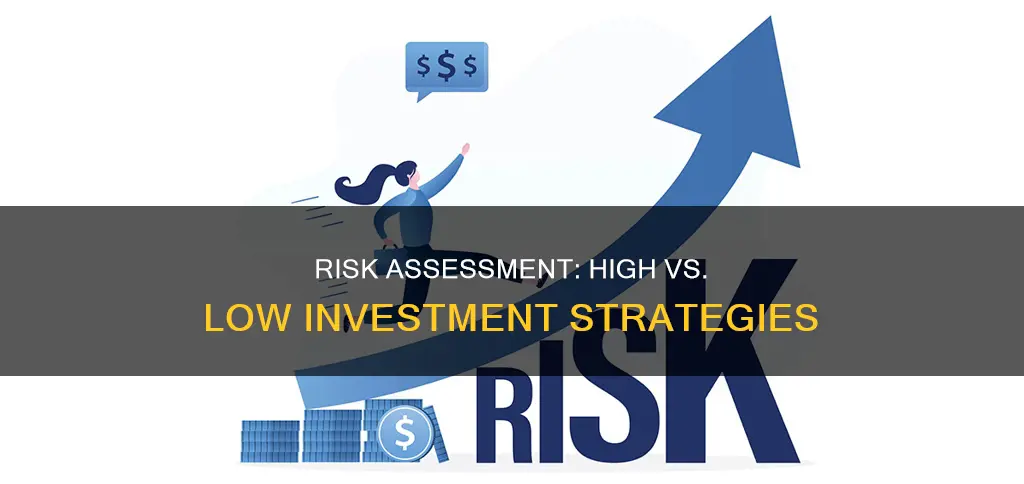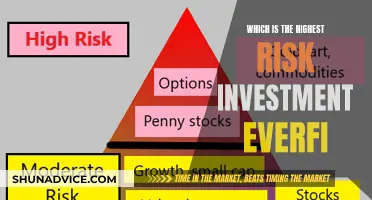
When it comes to investing, risk and reward are closely intertwined. High-risk investments are extreme and can give very high returns but also very high losses. Low-risk investments, on the other hand, are seen as safer bets that typically pull smaller returns. Risk is measured by the possibility of a decline in value and underperformance relative to expectations. Low-risk investing typically involves less stake, either monetarily or in terms of the portfolio's overall value. There is also less to gain, whether measured in terms of short-term profit or long-term advantages.
| Characteristics | High-Risk Investments | Low-Risk Investments |
|---|---|---|
| Risk | Higher risk of decline in value and underperformance | Lower risk of decline in value and underperformance |
| Returns | Higher potential returns | Lower potential returns |
| Losses | Higher potential losses | Lower potential losses |
| Consistency | Less consistent | More consistent |
| Volatility | More volatile | Less volatile |
What You'll Learn
- High-risk investments can lead to high returns, but also high losses
- Low-risk investments are safer bets, but they have smaller returns
- Risk is measured by the possibility of a decline in value and underperformance relative to expectations
- Low-risk investments are less likely to increase your wealth significantly
- A balanced portfolio should include a mix of high- and low-risk investments

High-risk investments can lead to high returns, but also high losses
Risk and reward are closely intertwined in the world of investing. High-risk investments can lead to high returns, but they can also result in high losses. This is because risk is measured by the possibility of a decline in value and underperformance relative to expectations.
High-risk investments are extreme and can give very high returns but also very high losses. For example, biotechnology stocks are notoriously risky as the vast majority of new experimental cures will fail, and most biotech stocks will eventually fail too. This means there is a high chance of underperformance and a large amount of potential underperformance.
On the other hand, low-risk investments tend to have lower potential returns. They typically involve less stake, either monetarily or in terms of the portfolio's overall value. There is also less to gain, whether in terms of short-term profit or long-term advantages. For example, a United States Treasury bond offers a very different risk profile to biotechnology stocks.
Despite the potential for bigger losses, high-risk investments offer the opportunity for larger gains. Low-risk investments are seen as safer bets that typically pull smaller returns. However, both types of investments can help bring you closer to your financial goals. A balanced portfolio should include a mix of both high- and low-risk investments. Safer options help to limit risk while providing more stability, while high-risk investments can lead to higher returns.
Strategizing Your Investment Portfolio: A Smart Division Guide
You may want to see also

Low-risk investments are safer bets, but they have smaller returns
Low-risk investments are generally safer bets than high-risk investments, but they also have smaller returns. Risk and reward are closely intertwined in the world of investing, and the higher the potential reward, the higher the risk. Low-risk investments tend to involve less stake, either in terms of money or the portfolio's overall value. There is also less to gain in the short or long term.
Low-risk investments are unlikely to increase your wealth significantly, but they can bring peace of mind. They are predictable and consistent, which can be reassuring for investors who are wary of market volatility. They can also help balance your portfolio and protect against market volatility.
High-risk investments, on the other hand, can lead to higher returns but also come with the possibility of bigger losses. They are extreme and can give very high returns, but these returns are not guaranteed.
A balanced portfolio should include a mix of both high- and low-risk investments. Safer options help limit risk while providing more stability, and high-risk investments can lead to higher returns.
The Future of Investment: Side-by-Side Management
You may want to see also

Risk is measured by the possibility of a decline in value and underperformance relative to expectations
On the other hand, low-risk investments are seen as safer bets that typically pull smaller returns. Low-risk investments on their own are unlikely to increase your wealth significantly, but they can bring peace of mind and help balance your portfolio. A United States Treasury bond offers a very different risk profile compared to biotechnology stocks.
Understanding the Private Equity Investment Cycle
You may want to see also

Low-risk investments are less likely to increase your wealth significantly
Low-risk investments are unlikely to increase your wealth significantly. While they are safer bets that can help bring you closer to your financial goals, they typically pull smaller returns. This is because risk and reward are intertwined: the higher the potential reward, the higher the risk.
Low-risk investments tend to involve less stake, either in terms of money or the portfolio's overall value. There is less to gain in the short or long term. For example, a United States Treasury bond offers a very different risk profile to biotechnology stocks, which are notoriously risky.
However, low-risk investments can bring peace of mind. Their predictability can help balance your portfolio and protect against market volatility. They are a good option for investors who have a tough time stomaching market volatility. A balanced portfolio should include both high- and low-risk investments.
While low-risk investments are less likely to increase your wealth significantly, they are a safer option that can help you reach your financial goals.
RBI's Portfolio Investment Scheme: A Guide
You may want to see also

A balanced portfolio should include a mix of high- and low-risk investments
Risk and reward are closely intertwined in the world of investing. Generally, the higher the potential reward, the higher the risk. High-risk investments can be extreme, and while they can give very high returns, they can also result in very high losses. On the other hand, low-risk investments tend to have lower potential returns, but losses are also rare. They are seen as safer bets that typically pull smaller returns.
The decision to invest in high- or low-risk opportunities depends on your investment goals and risk appetite. Low-risk investments on their own are unlikely to increase your wealth significantly, but their predictability can bring peace of mind and help balance your portfolio.
Understanding Investment: Liability or Equity?
You may want to see also
Frequently asked questions
High-risk investments have a large percentage chance of loss of capital or underperformance, or a relatively high chance of a devastating loss. Low-risk investments are the opposite.
Biotechnology stocks are an example of high-risk investments. Most new experimental cures fail, and most biotech stocks will eventually fail too. This means there is a high chance of underperformance and a large amount of potential underperformance.
United States Treasury bonds are an example of low-risk investments.
Possibility and probability are helpful tools when considering the risk of an investment. For example, if an investor expects a return of 25%, they are immediately placing a measure of the risk of loss on the venture.
High-risk investments tend to be more volatile than low-risk investments. Their value is very dependent on market confidence, which can change significantly from day to day.







